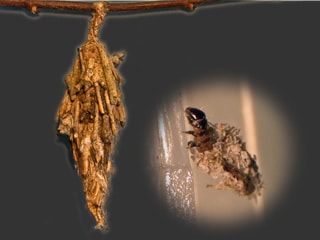 Description: The common bagworm is one of the more curious and interesting caterpillars. They are most commonly observed in the cone/carrot shaped silk bag, camouflaged with bits of foliage and bark. The bag enlarges as the bagworm grows and is carried wherever the bag worm travels. When disturbed, the larva immediately pulls its head into the bag for protection. Completed bags range from 1 ½ to 2 ½ inches long.
Description: The common bagworm is one of the more curious and interesting caterpillars. They are most commonly observed in the cone/carrot shaped silk bag, camouflaged with bits of foliage and bark. The bag enlarges as the bagworm grows and is carried wherever the bag worm travels. When disturbed, the larva immediately pulls its head into the bag for protection. Completed bags range from 1 ½ to 2 ½ inches long.
Over 100 species of plants are susceptible to bagworm feeding injury. They are especially fond of Leyland cypress, junipers, cedars, arborvitae and white pine.
Bagworms spend the winter as eggs inside the female’s bag. There may be 300-1000 eggs per bag. Eggs hatch in late-May or early-June. As they hatch the larvae leave the bag and spin down on a strand of silk. These larvae are easily blown by the wind and taken to nearby plants. When a suitable host is found the young larvae begins to form a new bag immediately, which starts at 1/8 inch long.
Throughout the summer the larvae feeds and grows, enlarging it’s bag and adding bits and pieces of plant material. The larvae are mature by mid-August and move to a sturdy branch where they attach the bag firmly with a strong band of silk. The larvae orient head down and begin to pupate. Within four weeks the male moths emerge and actively fly about searching for females. After mating, the female deposits a mass of eggs inside the bag and then drops to the ground to die. The eggs overwinter and hatch in spring.
Symptoms: Larvae eat the buds on conifers causing branch dieback and open, dead areas. Excessive defoliation of these conifers may cause death during the following season. Even moderate defoliation is unsightly. The band of silk used to attach the bag permanently may girdle the branch as it grows, resulting in dead branches several years later. Be sure to cut this silk band off the tree when removing bags from the plant.
Control: One control method is to handpick and destroy bags in the fall or winter before eggs hatch in the spring. On large trees this may be impractical or dangerous. Chemical controls should be timed when the bagworms are small and have minimal bags.
Thank you for reviewing this information. Schneider Tree Care is committed to preserving and enhancing the quality of your property through tree care education and services. We employ professionally trained and certified arborists who are available to meet with you for a consultation at no charge.
If you have any questions or need additional information regarding the health of your trees, please contact us.










